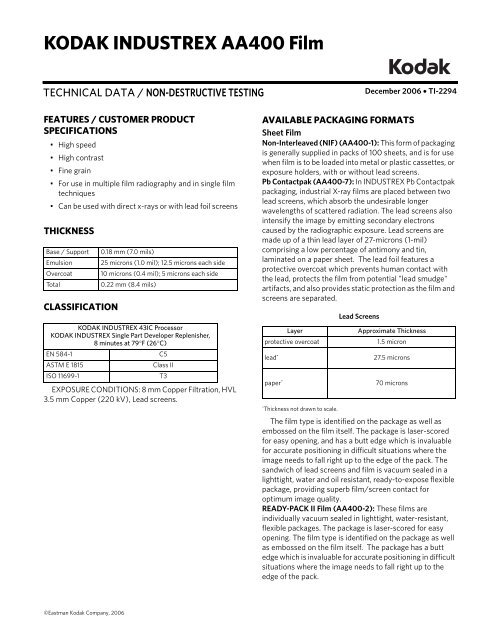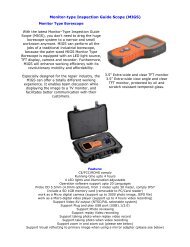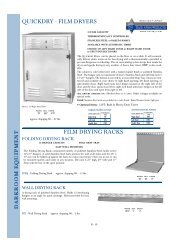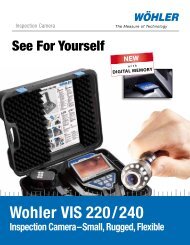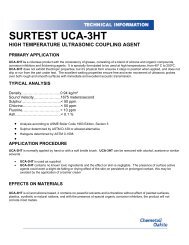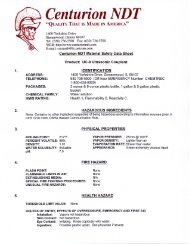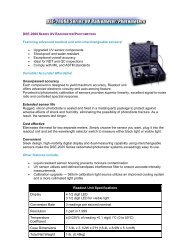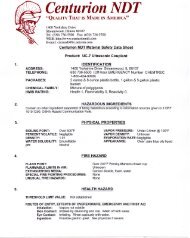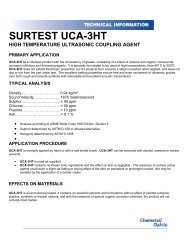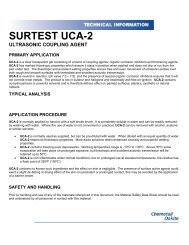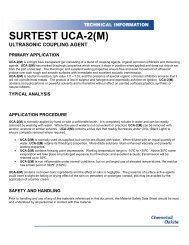KODAK INDUSTREX AA400 Film - NDTmart
KODAK INDUSTREX AA400 Film - NDTmart
KODAK INDUSTREX AA400 Film - NDTmart
You also want an ePaper? Increase the reach of your titles
YUMPU automatically turns print PDFs into web optimized ePapers that Google loves.
<strong>KODAK</strong> <strong>INDUSTREX</strong> <strong>AA400</strong> <strong>Film</strong><br />
TECHNICAL DATA / NON-DESTRUCTIVE TESTING<br />
December 2006 • TI-2294<br />
FEATURES / CUSTOMER PRODUCT<br />
SPECIFICATIONS<br />
• High speed<br />
• High contrast<br />
• Fine grain<br />
• For use in multiple film radiography and in single film<br />
techniques<br />
• Can be used with direct x-rays or with lead foil screens<br />
THICKNESS<br />
Base / Support<br />
Emulsion<br />
Overcoat<br />
Total<br />
CLASSIFICATION<br />
0.18 mm (7.0 mils)<br />
25 microns (1.0 mil); 12.5 microns each side<br />
10 microns (0.4 mil); 5 microns each side<br />
0.22 mm (8.4 mils)<br />
<strong>KODAK</strong> <strong>INDUSTREX</strong> 43IC Processor<br />
<strong>KODAK</strong> <strong>INDUSTREX</strong> Single Part Developer Replenisher,<br />
8 minutes at 79°F (26°C)<br />
EN 584-1<br />
C5<br />
ASTM E 1815<br />
Class II<br />
ISO 11699-1<br />
T3<br />
EXPOSURE CONDITIONS: 8 mm Copper Filtration, HVL<br />
3.5 mm Copper (220 kV), Lead screens.<br />
AVAILABLE PACKAGING FORMATS<br />
Sheet <strong>Film</strong><br />
Non-Interleaved (NIF) (<strong>AA400</strong>-1): This form of packaging<br />
is generally supplied in packs of 100 sheets, and is for use<br />
when film is to be loaded into metal or plastic cassettes, or<br />
exposure holders, with or without lead screens.<br />
Pb Contactpak (<strong>AA400</strong>-7): In <strong>INDUSTREX</strong> Pb Contactpak<br />
packaging, industrial X-ray films are placed between two<br />
lead screens, which absorb the undesirable longer<br />
wavelengths of scattered radiation. The lead screens also<br />
intensify the image by emitting secondary electrons<br />
caused by the radiographic exposure. Lead screens are<br />
made up of a thin lead layer of 27-microns (1-mil)<br />
comprising a low percentage of antimony and tin,<br />
laminated on a paper sheet. The lead foil features a<br />
protective overcoat which prevents human contact with<br />
the lead, protects the film from potential "lead smudge"<br />
artifacts, and also provides static protection as the film and<br />
screens are separated.<br />
Layer<br />
protective overcoat<br />
lead *<br />
paper *<br />
*Thickness not drawn to scale.<br />
Lead Screens<br />
Approximate Thickness<br />
1.5 micron<br />
27.5 microns<br />
70 microns<br />
The film type is identified on the package as well as<br />
embossed on the film itself. The package is laser-scored<br />
for easy opening, and has a butt edge which is invaluable<br />
for accurate positioning in difficult situations where the<br />
image needs to fall right up to the edge of the pack. The<br />
sandwich of lead screens and film is vacuum sealed in a<br />
lighttight, water and oil resistant, ready-to-expose flexible<br />
package, providing superb film/screen contact for<br />
optimum image quality.<br />
READY-PACK II <strong>Film</strong> (<strong>AA400</strong>-2): These films are<br />
individually vacuum sealed in lighttight, water-resistant,<br />
flexible packages. The package is laser-scored for easy<br />
opening. The film type is identified on the package as well<br />
as embossed on the film itself. The package has a butt<br />
edge which is invaluable for accurate positioning in difficult<br />
situations where the image needs to fall right up to the<br />
edge of the pack.<br />
©Eastman Kodak Company, 2006
Roll <strong>Film</strong><br />
READY-PACK (<strong>AA400</strong>-381): The film is supplied in a long,<br />
lighttight roll sandwiched between two yellow-black paper<br />
polyethylene layers. The rolls are of 60- or 100-metre<br />
lengths in a variety of widths. The film is provided in a<br />
dispenser box and is cut to length by the user in a<br />
darkroom.<br />
LEAD PACK (<strong>AA400</strong>-382): The film is supplied<br />
sandwiched between two 27-micron thick lead screens<br />
inside a long, light-tight paper and polyethylene sleeve (see<br />
Pb Contactpak above for lead screen description). The<br />
rolls are 100 metres long and are cut to length by the user<br />
in a darkroom.<br />
NIF bulk roll (<strong>AA400</strong>-359): The film is supplied on a<br />
cardboard core in rolls 150 metres long in three widths: 60<br />
mm, 70 mm and 100 mm. The film must be loaded into a<br />
cassette in a darkroom.<br />
SAFELIGHT RECOMMENDATIONS<br />
Use a <strong>KODAK</strong> LED Safelight (660 nm red) or a red safelight<br />
filter (i.e. <strong>KODAK</strong> 1, 1A, or 2 Safelight Filter) in a suitable<br />
safelight lamp equipped with a 15-watt bulb. Keep the film<br />
at least 4 feet (1.2 metres) from the safelight.<br />
Note: Other safelight filters (i.e. <strong>KODAK</strong> 8 and GBX-2<br />
Safelight Filter) which block radiation at 550nm and<br />
shorter wavelengths are also suitable for use.<br />
STORAGE AND HANDLING<br />
Handle film carefully to avoid physical strains such as<br />
pressure, creasing, or buckling.<br />
It is important to realize that meeting the chemical and<br />
physical requirements does not by itself ensure that<br />
records will not deteriorate. It is essential to provide proper<br />
storage conditions. ASTM E 1254 gives details of storage<br />
conditions. ISO 18911 and ISO 18902 give, for processed<br />
films, recommended storage conditions and specifications<br />
for the respective enclosure materials.<br />
Unexposed<br />
50 to 70°F (10 to 21°C), 30 to 50% RH. Properly shield<br />
from x-rays, gamma rays, or other penetrating radiation.<br />
Exposed<br />
Keep cool, dry, and properly shielded from penetrating<br />
radiation. Process as soon as possible after exposure.<br />
Processed<br />
60 to 80°F (15 to 27°C), 30 to 50% RH.<br />
RELATIVE EXPOSURE<br />
EXPOSURE CONDITIONS: 8 mm Copper Filtration, HVL<br />
3.5 mm Copper (220 kV), Lead screens<br />
<strong>KODAK</strong><br />
<strong>INDUSTREX</strong> <strong>Film</strong>s<br />
* <strong>AA400</strong> <strong>Film</strong> in 8 min 79°F (26°C) cycle is assigned a relative exposure of 1.<br />
RELATIVE EXPOSURE FOR VARIOUS ENERGY<br />
LEVELS<br />
For each exposure condition, <strong>AA400</strong> <strong>Film</strong> in 8 minutes,<br />
79°F (26°C), is assigned a relative exposure of 1.00.<br />
* In accordance with ISO 7004 standard. Without lead screens<br />
† In accordance with ISO 7004 standard - EN 584-1 Lead screens<br />
‡ 8 mm Copper filtration. 100/200 microns lead screens<br />
§ 100/200 microns lead screens<br />
AUTOMATIC PROCESSING<br />
<strong>KODAK</strong> <strong>INDUSTREX</strong> Processor<br />
<strong>KODAK</strong> <strong>INDUSTREX</strong> Chemicals<br />
8 min 79°F (26°C)<br />
DR50 7.2<br />
M100 4.2<br />
MX125 2.8<br />
T200 1.7<br />
<strong>AA400</strong> * 1.0<br />
HS800 0.5<br />
<strong>INDUSTREX</strong><br />
<strong>Film</strong>s<br />
ISO 120kV * EN 220kV † Iridium ‡ Cobalt §<br />
DR50 9.0 7.2 9.0 9.0<br />
M100 4.1 4.2 5.4 6.3<br />
MX125 2.9 2.8 3.1 3.3<br />
T200 1.6 1.7 1.9 1.9<br />
<strong>AA400</strong> 1.0 1.0 1.0 1.0<br />
HS800 — 0.5 — —<br />
Notice: Observe precautionary information on product labels and on the<br />
Material Safety Data Sheets.<br />
See Kodak publication TI-2621, Processing <strong>KODAK</strong><br />
<strong>INDUSTREX</strong> <strong>Film</strong>s, for additional information on automatic<br />
processing.<br />
EXPOSURE CONDITIONS: 200/220 kV, ISO/ANSI/EN<br />
Conditions, <strong>KODAK</strong> <strong>INDUSTREX</strong> Chemicals<br />
<strong>Film</strong> Characteristics (Sensitometric)<br />
<strong>KODAK</strong> <strong>INDUSTREX</strong><br />
Processor / Cycle<br />
Base + Fog Contrast *<br />
M43IC, 8 min 79°F (26°C) 0.20 4.7<br />
M43IC, 5 min 86°F (30°C) 0.20 4.65<br />
M35, 8 min 82°F (28°C) 0.24 4.5<br />
* Contrast calculated between net densities of 1.5 and 3.5.<br />
2 <strong>KODAK</strong> <strong>INDUSTREX</strong> <strong>AA400</strong> <strong>Film</strong> • TI-2294
Recommended Replenishment Rates<br />
The consistency of the radiographic quality is related to the<br />
accurate adjustment of the replenishment rate.<br />
Replenishment should maintain the chemical equilibrium,<br />
replacing the components used by the film.<br />
Solution<br />
* For optimum archivability, a 10% increase in fixer replenishment rate may be<br />
desirable.<br />
Washing and Drying<br />
Washing: Follow the processor manufacturer's<br />
recommendation for wash flow rate, or adjust flow to<br />
achieve the equivalent of the wash tank capacity every five<br />
minutes, or twelve tank volumes per hour. Insufficient<br />
wash flow can adversely affect the life expectancy of<br />
processed radiographs. Wash flow rate should be<br />
increased if chemical spot tests or other analytical<br />
methods reveal a high level of retained chemicals in the<br />
processed film. For best results, the wash tank should be<br />
drained daily and left empty when not in use.<br />
Drying: Follow the processor manufacturer's<br />
recommendation for dryer settings. In general, the dryer<br />
should be set to a temperature slightly above (3°C/5°F)<br />
the lowest temperature required to eliminate any signs of<br />
tackiness in films exiting the dryer.<br />
MANUAL PROCESSING<br />
Replenishment Volume<br />
per 35 x 43 cm<br />
per m<br />
(14 x 17 inch) sheet<br />
2<br />
Developer 100 mL 665 mL<br />
Fixer 180 mL * 1200 mL<br />
Notice: Observe precautionary information on product labels and on the<br />
Material Safety Data Sheets.<br />
See Kodak publication TI-2643, Guide to Manual<br />
Processing of NDT <strong>Film</strong>s, for additional information on<br />
manual processing.<br />
<strong>Film</strong> Characteristics (Sensitometric)<br />
Development<br />
Conditions<br />
Base + Fog Contrast *<br />
5 min 68° (20°C) 0.25 4.2<br />
3 min 75° (24°C) 0.20 4.3<br />
2.5 min 86°F (30°C) 0.24 4.2<br />
* Contrast calculated between net densities of 1.5 and 3.5.<br />
Development<br />
Develop with rack and tank, using properly replenished<br />
solutions.<br />
<strong>KODAK</strong><br />
<strong>INDUSTREX</strong><br />
Single Part<br />
Developer<br />
Replenisher<br />
• Remove film and hanger 5 seconds before end of<br />
development. DO NOT ALLOW EXCESS DEVELOPER<br />
TO DRAIN BACK INTO THE TANK. Normally this will<br />
carry out the proper amount of solution to permit<br />
correct replenishment.<br />
• Use floating covers on developer tanks to reduce<br />
oxidation and evaporation; store developer<br />
replenisher in a closed container.<br />
• Fill the developer and fixer tank to its original level<br />
each morning with developer or fixer replenisher<br />
solution (topping off).<br />
• Discard solution after adding two tank volumes of<br />
replenisher to tank, or at least once a month, and refill<br />
with fresh solution.<br />
Stop, Fix, Wash and Dry Steps<br />
<strong>KODAK</strong> Indicator<br />
Stop Bath,<br />
or acetic acid<br />
(diluted to 3.5%)<br />
solution<br />
<strong>KODAK</strong> Rapid<br />
Fixer, <strong>KODAK</strong><br />
<strong>INDUSTREX</strong><br />
Manual Fixer, or<br />
<strong>KODAK</strong><br />
<strong>INDUSTREX</strong> LO<br />
Fixer and<br />
Replenisher<br />
Running water<br />
wash<br />
(8 volume<br />
changes per hour)<br />
Temperature<br />
68°F (20°C)<br />
72°F (22°C)<br />
75°F (24°C)<br />
79°F (26°C)<br />
Temperature<br />
60 to 85°F<br />
16 to 30°C<br />
60 to 85°F<br />
16 to 30°C<br />
60 to 85°F<br />
16 to 30°C<br />
Recommended<br />
Time<br />
(Minutes)<br />
Agitation<br />
Stop baths check development, prevent most spots or<br />
streaks, and prolong the life of the fixing bath.<br />
Immerse the film in fixer for 3 to 6 minutes, agitating for<br />
5 seconds every 30 seconds. <strong>Film</strong> should remain in fixer<br />
for twice the time it takes to "clear" it (when the milky look<br />
disappears). Never fix film for less than 3 minutes.<br />
<strong>KODAK</strong> Hypo Clearing Agent may be used following the<br />
fixer to reduce washing time and conserve water. First<br />
rinse films in running water for 30 seconds, the use Hypo<br />
Clearing Agent for 1 to 2 minutes, followed by a final<br />
running water wash for 5 minutes.<br />
5<br />
4<br />
3<br />
2<br />
Recommended<br />
Time<br />
30 to 60<br />
seconds<br />
3 to 6 minutes,<br />
or twice the<br />
clearing time<br />
10 to 30<br />
Minutes<br />
Intermittent<br />
(5 seconds<br />
every 30<br />
seconds)<br />
Agitation<br />
Continuous,<br />
Moderate<br />
Vigorous for<br />
15 seconds,<br />
then<br />
intermittent<br />
(5 sec every<br />
30 sec)<br />
<strong>KODAK</strong> <strong>INDUSTREX</strong> <strong>AA400</strong> <strong>Film</strong> • TI-2294 3
<strong>KODAK</strong> <strong>INDUSTREX</strong> <strong>AA400</strong> <strong>Film</strong><br />
To minimize water spots and drying marks, use <strong>KODAK</strong><br />
PHOTO-FLO Solution after washing.<br />
Dry in a dust-free area at room temperature or in a<br />
suitable drying cabinet. Temperature not to exceed 120°F<br />
(50°C).<br />
Recommended Replenishment Rates<br />
Maintain chemical activity and solution level in the<br />
developer tank by adding 100 ml (3.38 fluid ounces) of<br />
replenisher according to instructions for each 14 x 17-inch<br />
(35 x 43 cm) film processed. Stir vigorously after each<br />
addition. Replenish the fixer tank at the rate of 180 mL (6<br />
fluid ounces) per 35 x 43 cm (14 x 17 in) sheet of film<br />
processed.<br />
CURVES<br />
DENSITY<br />
7.0<br />
6.0<br />
5.0<br />
4.0<br />
3.0<br />
2.0<br />
1.0<br />
Characteristic Curves, Machine Processing<br />
Process: <strong>KODAK</strong> <strong>INDUSTREX</strong> Processor<br />
<strong>KODAK</strong> <strong>INDUSTREX</strong> Chemicals<br />
Exposure: 200/220 kV X-rays<br />
with Lead Screens<br />
Densitometry: Diffuse Visual<br />
8 min 79F (26C)<br />
7.0<br />
6.0<br />
5.0<br />
Characteristic Curves, Manual Processing<br />
Exposure: 200/220 kV X-rays<br />
with Lead Screens<br />
Process: Manual<br />
Densitometry: Diffuse Visual<br />
5 min 68F (20C)<br />
3 min 75F (24C)<br />
0.0<br />
3.0 2.0 1.0 0.0 1.0<br />
LOG EXPOSURE (Roentgens)<br />
DENSITY<br />
4.0<br />
3.0<br />
2.0<br />
1.0<br />
0.0<br />
3.0 2.0 1.0 0.0 1.0<br />
LOG EXPOSURE (Roentgens)<br />
NOTICE: While the sensitometric data in this publication are typical of production coatings, they do not<br />
represent standards which must be met by Kodak. Varying storage, exposure, and processing conditions will<br />
affect results. The company reserves the right to change and improve product characteristics at any time.<br />
Kodak, Industrex, Lead Pack, Ready-Pack, and Photo-flo are trademarks.<br />
Revised 12-06<br />
Printed in U.S.A.<br />
<strong>KODAK</strong> <strong>INDUSTREX</strong> <strong>AA400</strong> <strong>Film</strong><br />
<strong>KODAK</strong> Publication No. TI-2294<br />
Aerial and Industrial Markets<br />
EASTMAN <strong>KODAK</strong> COMPANY • ROCHESTER, NY 14650-0505


